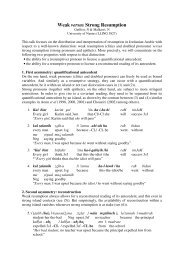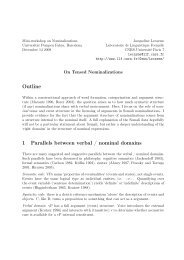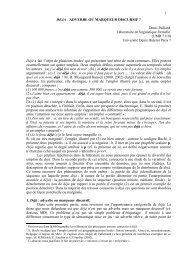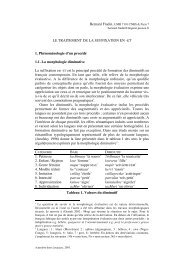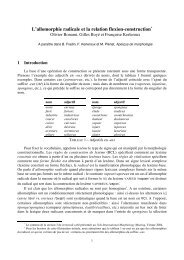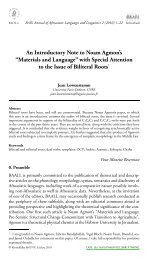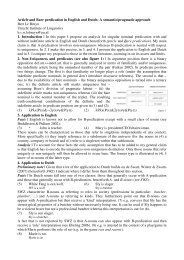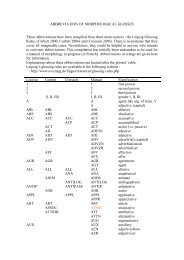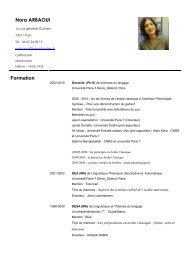On the Semantics of Denominal Adjectives - Laboratoire de ...
On the Semantics of Denominal Adjectives - Laboratoire de ...
On the Semantics of Denominal Adjectives - Laboratoire de ...
You also want an ePaper? Increase the reach of your titles
YUMPU automatically turns print PDFs into web optimized ePapers that Google loves.
1. Introduction<br />
<strong>On</strong> <strong>the</strong> <strong>Semantics</strong> <strong>of</strong> <strong>Denominal</strong> <strong>Adjectives</strong><br />
Bernard Fradin<br />
<strong>Laboratoire</strong> <strong>de</strong> linguistique formelle<br />
CNRS & University <strong>of</strong> Paris 7 Denis Di<strong>de</strong>rot<br />
bernard.fradin@linguist.jussieu.fr<br />
<strong>Denominal</strong> adjectives are complex adjectives morphologically constructed on a<br />
nominal basis, <strong>the</strong> base noun (abbreviated here as BseN). They can be formed by many<br />
different <strong>de</strong>rivational processes as tableau1 attests for French.<br />
Tableau 1. Varieties <strong>of</strong> <strong>de</strong>nominal adjectives<br />
SFX BseN Gloss A Gloss<br />
-AIN Afrique ‘Africa’ africain ‘African’<br />
-É io<strong>de</strong> ‘iodine’ iodé ‘iodized’<br />
-EL an ‘year’ annuel ‘annual’<br />
-ESQUE Dante ‘Dante’ dantesque ‘Dantesque’<br />
-EUX lait ‘milk’ laiteux ‘milky’<br />
-IEN caméléon ‘chameleon’ caméléonien ‘chameleonic’<br />
-IN opale ‘opal’ opalin ‘opalin’<br />
-IQUE basalte ‘basalt’ basaltique ‘basaltic’<br />
-U branche ‘branch’ branchu ‘branched’<br />
If we classify adjectives according to <strong>the</strong> classical distributional criteria given in<br />
tableau 2, we see that <strong>de</strong>nominal adjectives range in several distinct subclasses, as<br />
shown in tableau 3.<br />
Tableau 2. Distributional criteria for A classification<br />
Predicative position NP COPULA A Jane (is + became) sad<br />
Prenominal position A N big tree<br />
Postnominal position N A stars visible<br />
Gradable DEG A very angry / completely full<br />
Tableau 3. Adjectival subclasses<br />
(Aa) (Ab) (Ba) (Bb) (Ca) (Cb)<br />
1. Pred. – – + + + +<br />
2. A N – – – – – +<br />
3. N A + + + + + +<br />
4. Grad. – – – – + +<br />
5. Denom. – + – + + +<br />
Examples : (Aa) ca<strong>de</strong>t ‘ca<strong>de</strong>t’, (Ab) prési<strong>de</strong>ntiel ‘presi<strong>de</strong>ntial’, (Ba) borgne ‘one-eyed’,<br />
Geert Booij, Angela Ralli & Sergio Scalise. 2008. <strong>On</strong> line proceedings <strong>of</strong> <strong>the</strong> 6 th Mediterranean<br />
Morphology Meeting. Sept. 27-30, 2007. Ithaca Greece.
(Bb) mensuel ‘monthly’, (Ca) pansu ‘paunchy’, (Cb) courageux ‘courageous’, léger<br />
‘light’.<br />
In tableau 3, <strong>de</strong>nominal adjectives have value ‘+’ for property 5 ‘<strong>de</strong>nominal’. All<br />
<strong>de</strong>nominal adjectives occur in <strong>the</strong> postnominal attributive structure. The <strong>de</strong>nominal<br />
adjectives I am interested in here are true relational adjectives, namely those in (Ab),<br />
which cannot occur in a predicative position e.g. *La voiture garée là-bas est<br />
prési<strong>de</strong>ntielle ‘<strong>the</strong> car parked over <strong>the</strong>re is presi<strong>de</strong>ntial’. This property sets <strong>the</strong>m apart<br />
from o<strong>the</strong>r subgroups <strong>of</strong> <strong>de</strong>nominal adjectives, inasmuch as <strong>the</strong> latter can appear after<br />
<strong>the</strong> copula (cf. (Bb), (Ca), (Cb)). Moreover, <strong>de</strong>nominal adjectives <strong>of</strong> type (Cb), e.g.<br />
osseux ‘bony’, may shift from one group to ano<strong>the</strong>r in function <strong>of</strong> <strong>the</strong> semantic<br />
relationship existing between <strong>the</strong> noun which heads <strong>the</strong> NP (<strong>the</strong> head noun, HdN) and<br />
<strong>the</strong> base noun. For instance, while osseux behaves like a relational adjective in (1), it<br />
behaves like a plain predicative A, e.g. léger ‘light’, in (2).<br />
(1) a. tuberculose osseuse ‘bone tuberculosis’<br />
b. *tuberculose très osseuse ‘very bone tuberculosis’<br />
c. ?*sa tuberculose est osseuse ‘his tubercolosis is (a) bone tuberculosis’<br />
(2) a. visage osseux ‘bony face’<br />
b. visage très osseux ‘very bony face’<br />
c. son visage est osseux ‘his face is bony’<br />
The reason why I limit myself to adjectives (Ab) <strong>of</strong> tableau 3 is that <strong>the</strong>ir properties<br />
place <strong>the</strong>m at one end <strong>of</strong> <strong>the</strong> scale on which <strong>de</strong>nominal adjectives can be ranked, <strong>the</strong><br />
o<strong>the</strong>r end being occupied by adjectives like courageux, which do not differ from<br />
ordinary <strong>de</strong>scriptive adjectives. <strong>Adjectives</strong> such as mensuel ‘monthly’ and pansu<br />
‘paunchy’, on <strong>the</strong> o<strong>the</strong>r hand, occupy positions in-between since <strong>the</strong>y also share<br />
properties <strong>of</strong> ordinary adjectives. To that extent, relational adjectives (Ab) appear to be<br />
more typical <strong>de</strong>nominal adjectives than <strong>the</strong> o<strong>the</strong>r ones. In my opinion, it is easier to<br />
<strong>de</strong>scribe typical specimens <strong>of</strong> a category than less typical ones.<br />
The scope <strong>of</strong> this article is to account for <strong>the</strong> interpretation <strong>of</strong> <strong>de</strong>nominal adjectives<br />
in a postnominal position. In section 2, after reviewing general properties <strong>of</strong> <strong>de</strong>nominal<br />
adjectives, I discuss some existing analyses and examine possible mechanisms in charge<br />
<strong>of</strong> <strong>the</strong>ir interpretation. Section 3 proposes such a mechanism for two standard cases, one<br />
where <strong>the</strong> <strong>de</strong>nominal adjective exhibits an eventive reading and <strong>the</strong> o<strong>the</strong>r where we<br />
have a spatial reading. The last sections <strong>de</strong>al with more complex cases. Section 4<br />
focuses on prefixed <strong>de</strong>nominal adjectives such as pré-électoral ‘pre-election’ and<br />
section 5 extends <strong>the</strong> analysis to morphologically un<strong>de</strong>rived adjectives such as<br />
intergalactique ‘intergalactic’.<br />
2. General properties <strong>of</strong> <strong>de</strong>nominal adjectives<br />
2.1. Morphological structure<br />
I assume that <strong>de</strong>nominal adjectives have <strong>the</strong> structure examplified in figure 1,<br />
couched here in a typed-feature formalism (cf. Sag & Wasow 1999). A-<strong>de</strong>n (<strong>de</strong>nominal<br />
adjective) notes <strong>the</strong> lexical type <strong>of</strong> <strong>the</strong> adjective. Feature MORPH-ST (Morphological<br />
structure), whose value is a sign, gives <strong>the</strong> structure <strong>of</strong> <strong>the</strong> N which is <strong>the</strong> base <strong>of</strong> <strong>the</strong><br />
adjective. Schematic though it is, <strong>the</strong> structure <strong>of</strong> fig. 1 notes two important properties<br />
2
<strong>of</strong> <strong>de</strong>nominal adjectives. First, <strong>the</strong> fact that <strong>the</strong>ir phonology (PHON) is equivalent to <strong>the</strong><br />
concatenation <strong>of</strong> <strong>the</strong> phonology <strong>of</strong> <strong>the</strong> base with a suffix (chosen among those<br />
mentioned in tableau 1). Second, <strong>the</strong> fact that <strong>the</strong> semantics <strong>of</strong> <strong>the</strong> <strong>de</strong>rived adjective is<br />
<strong>the</strong> same as <strong>the</strong> semantics <strong>of</strong> its base noun. This is expressed through <strong>the</strong> shared value<br />
[2] <strong>of</strong> <strong>the</strong> feature REL (RELATION), itself a value <strong>of</strong> <strong>the</strong> feature CONT (CONTENT).<br />
Figure 2 gives <strong>the</strong> schematic representation <strong>of</strong> <strong>the</strong> <strong>de</strong>nominal adjective PRÉSIDENTIEL. 1<br />
!<br />
$ A " <strong>de</strong>n<br />
'<br />
&<br />
)<br />
&<br />
PHON [1] # sfx<br />
)<br />
& $ HEAD [ CAT a]<br />
'<br />
)<br />
& SYN - SEM &<br />
)<br />
)<br />
& % & CONT [ REL [2] ] ( )<br />
)<br />
&<br />
)<br />
&<br />
$<br />
'<br />
)<br />
&<br />
&<br />
)<br />
)<br />
&<br />
& Noun<br />
)<br />
)<br />
&<br />
&<br />
)<br />
MORPH "ST<br />
&<br />
PHON [1]<br />
)<br />
&<br />
)<br />
)<br />
&<br />
& $ HEAD [ CAT n]<br />
' )<br />
)<br />
&<br />
& SYN - SEM &<br />
)<br />
%<br />
% & % & CONT [ REL [2] ] ( ) ( )<br />
)<br />
(<br />
Figure 1. Structure <strong>of</strong> <strong>de</strong>nominal adjectives<br />
$ A " <strong>de</strong>n<br />
'<br />
&<br />
)<br />
&<br />
PHON [1] # El<br />
)<br />
& $ HEAD [ CAT a]<br />
'<br />
)<br />
& SYN - SEM &<br />
)<br />
)<br />
& % & CONT [ REL [2] ] ( )<br />
)<br />
&<br />
)<br />
&<br />
$<br />
'<br />
)<br />
&<br />
&<br />
)<br />
Noun<br />
)<br />
&<br />
&<br />
)<br />
)<br />
& MORPH - ST & PHON [1] /prezidãt/<br />
)<br />
)<br />
&<br />
&<br />
)<br />
& $ HEAD [ CAT n]<br />
' )<br />
&<br />
)<br />
& SYN - SEM &<br />
) )<br />
)<br />
% &<br />
% % CONT [REL [2] presi<strong>de</strong>nt' ( )<br />
Figure 2. Structure <strong>of</strong> adjective prési<strong>de</strong>ntiel<br />
2.2. The ! semantics <strong>of</strong> relational adjectives<br />
As <strong>the</strong> above-mentioned representations state, relational adjectives are semantically<br />
transparent. I contend that <strong>the</strong>ir only semantic import is to indicate that <strong>the</strong>ir base noun<br />
is a potential argument <strong>of</strong> a semantic relation R. Two views exist as regards relation R :<br />
a purely contextual one and a mixed one.<br />
The contextual approach claims that R’s value is always supplied by <strong>the</strong> context. It<br />
has been argued for by Mezhevich (2004) and endorsed by several o<strong>the</strong>r researchers<br />
(Mcnally & Boleda 2004). <strong>On</strong> this view, expression (3a) receives semantic<br />
representation (3b) and <strong>the</strong> value <strong>of</strong> R is contextually <strong>de</strong>termined.<br />
1 <strong>On</strong> <strong>the</strong> apparition <strong>of</strong> <strong>the</strong> semi-vowel /j/, see Thornton (1999).<br />
3
(3) a. presi<strong>de</strong>ntial adviser<br />
b. (λx. adviser’(x) ∧ R(x, presi<strong>de</strong>nt’))<br />
The mixed approach says that ei<strong>the</strong>r <strong>the</strong> semantic representation <strong>of</strong> ei<strong>the</strong>r HdN or<br />
BseN can provi<strong>de</strong> us with R. O<strong>the</strong>rwise, or in addition, <strong>the</strong> relation is supplied by <strong>the</strong><br />
context (<strong>the</strong> <strong>de</strong>fault option). For instance, if we assume that (4b) is <strong>the</strong> representation<br />
associated with (4a), any <strong>of</strong> <strong>the</strong> predicates mentioned in (4c) can be used to instanciate<br />
R. Predicates live-in’ and build’ come from <strong>the</strong> semantic representation associated to<br />
palace (cf. below), while possess’ would be a <strong>de</strong>fault relation triggered by <strong>the</strong> animacy<br />
<strong>of</strong> <strong>the</strong> BseN’s referent.<br />
(4) a. palais prési<strong>de</strong>ntiel ‘presi<strong>de</strong>ntial palace’<br />
b. T(palais prési<strong>de</strong>ntiel) = (λx. R(x,y) ∧ palace’(x) ∧ presi<strong>de</strong>nt’(y))<br />
c. R = {live-in’, build’, possess’…}<br />
What are <strong>the</strong> arguments supporting one approach ra<strong>the</strong>r <strong>the</strong> o<strong>the</strong>r? The next<br />
subsection discusses this issue and is <strong>de</strong>voted to <strong>the</strong> survey <strong>of</strong> Mezhevich’s position.<br />
2.3. Mezhevich’s point <strong>of</strong> view<br />
Mezhevich’s argumentation is articulated in three points. <strong>On</strong> <strong>the</strong> basis <strong>of</strong> data like<br />
(5), she first argues that <strong>the</strong> values <strong>of</strong> R in constructs with a <strong>de</strong>nominal adjective (DA<br />
constructs) 2 seem arbitrary and that <strong>the</strong>ir range is potentially unlimited.<br />
(5) a. moloč-n-yj magazin<br />
milk-AZR-M.SG store:M:SG<br />
‘store that sells dairy products’<br />
b. moloč-n-aja ferma<br />
milk-AZR-F.SG farm:F:SG<br />
‘farm that products dairy products’<br />
c. moloč-n-yj stakan<br />
milk-AZR-M.SG glass:M:SG<br />
‘glass for milk’<br />
d. moloč-n-yj koktel<br />
milk-AZR-F.SG cocktail:M:SG<br />
‘milk cocktail’<br />
We agree with Mezhevich that <strong>the</strong> range <strong>of</strong> readings allowed by <strong>de</strong>nominal adjective<br />
is very wi<strong>de</strong>, but this does not mean that <strong>the</strong> value <strong>of</strong> R is arbitrary. If it were such, any<br />
<strong>of</strong> <strong>the</strong> DA construct above could show any <strong>of</strong> <strong>the</strong> attested reading, which is not true. For<br />
instance, normally, (5c) cannot mean ‘glass ma<strong>de</strong> <strong>of</strong> milk’, or (5b) ‘store that products<br />
dairy products’ because <strong>of</strong> <strong>the</strong> meaning attached to stakan and magazin. Secondly, she<br />
states that R’s value crucially <strong>de</strong>pends on <strong>the</strong> meaning <strong>of</strong> HdN, BseN and <strong>the</strong><br />
knowledge <strong>of</strong> <strong>the</strong> world. But she adds, third point, that <strong>the</strong> arbitrariness <strong>of</strong> <strong>the</strong> relation<br />
makes it more <strong>de</strong>pen<strong>de</strong>nt on <strong>the</strong> contextual knowledge. Example (6) is a case in point,<br />
2 <strong>Denominal</strong> adjective constructs (DAC) are incomplete NPs with a DA (NPDA) e.g. palais prési<strong>de</strong>ntiel.<br />
They are incomplete in French because <strong>the</strong>y lack a <strong>de</strong>terminant.<br />
4
since it clearly exhibits a purpose relation whereas, according to Mezhevich, nei<strong>the</strong>r<br />
zamok ‘lock’ nor skvažina ‘hole’ expresses a relation <strong>of</strong> purpose.<br />
(6) zamoč-n-aja skvažina<br />
lock-AZR-F.SG hole:F:SG<br />
‘keyhole’<br />
Point 2 is true, but point 3 lacks compelling support. Skvažina seems to <strong>de</strong>note a hole<br />
dug on purpose as examples (7) show, whereas o<strong>the</strong>r Russian translation <strong>of</strong> hole e.g.<br />
dyra ‘hole’, jama ‘pit, hole’, ščel’ ‘chink, crack, slit’, otverstie ‘slot, opening’ are not so<br />
overtly telic. The first three generally <strong>de</strong>note holes <strong>the</strong> existence <strong>of</strong> which results from<br />
natural causes.<br />
(7) a. nefta-n-aja skvažina<br />
oil-AZR-F.SG hole:F:SG<br />
‘oil well’<br />
b. bur-ov-aja skvažina<br />
drill-AZR-F.SG hole:F:SG<br />
‘drill well’<br />
The same reasoning extends to o<strong>the</strong>r examples <strong>of</strong> (5), since all HdNs <strong>the</strong>re<strong>of</strong> <strong>de</strong>note<br />
a functional-artefact (store, glass, farm).<br />
Jensen and Vikner’s experiment on genitive interpretation suggests ano<strong>the</strong>r argument<br />
in favor <strong>of</strong> <strong>the</strong> i<strong>de</strong>a that, in most cases, relation R can be recovered from <strong>the</strong> interaction<br />
<strong>of</strong> HdN and BseN’s meanings and that making use <strong>of</strong> <strong>the</strong> context to find an a<strong>de</strong>quate<br />
pragmatic interpretation is a last resort strategy, not a basic strategy. In <strong>the</strong>ir paper<br />
(Jensen & Vikner 2002), Jensen and Vikner report an experiment <strong>the</strong>y performed on <strong>the</strong><br />
interpretation <strong>of</strong> genitive phrases such as <strong>the</strong> N <strong>of</strong> N, <strong>the</strong> N’s N, etc. In a corpus <strong>of</strong><br />
fictional and non fictional texts in English, <strong>the</strong>y found 2,333 genitive forms, <strong>of</strong> which<br />
only 9 had a pragmatic interpretation. As an example <strong>of</strong> pragmatic interpretation, <strong>the</strong>y<br />
give <strong>the</strong> phrase “<strong>the</strong> <strong>de</strong>af mute’s pen” which had to be interpreted as ‘<strong>the</strong> pen he had<br />
bought from <strong>the</strong> <strong>de</strong>af mute’ in <strong>the</strong> book’s context. The very low rate <strong>of</strong> contextual<br />
interpretation is at odds with <strong>the</strong> view that it is <strong>the</strong> basic interpretive strategy. As has<br />
<strong>of</strong>ten been stressed (Partee & Borschev 2003, 2001), <strong>the</strong> problems <strong>of</strong> interpretation<br />
raised by NPDAs are akin to those raised by genitives, which makes Jensens and<br />
Vikner’s finding relevant for <strong>the</strong> present discussion. It remains clear however that a<br />
conclusive argument about <strong>the</strong> interpretation <strong>of</strong> <strong>de</strong>nominal adjective hinges on checking<br />
<strong>the</strong>ir interpretation on corpora in French through experiments similar to <strong>the</strong> one carried<br />
out by Jensen and Vikner. I leave this task for future research.<br />
The third argument that can be put to <strong>the</strong> fore against a purely contextual approach is<br />
tied to <strong>the</strong> contrast between (1) visage très osseux and (2) *tuberculose très osseuse.<br />
The point is that this constrast in grammaticality is <strong>de</strong>termined only on <strong>the</strong> basis <strong>of</strong><br />
information supplied by <strong>the</strong> HdN and <strong>the</strong> BseN (Fradin 2007, 2008 (to appear)). This<br />
downplays <strong>the</strong> role <strong>of</strong> context in <strong>the</strong> story, since we can do without it in this latter case.<br />
To sum up, <strong>the</strong> mixed approach, according to which relation R is established on <strong>the</strong><br />
basis <strong>of</strong> <strong>the</strong> meaning <strong>of</strong> both <strong>the</strong> HdN and <strong>the</strong> BseN on <strong>the</strong> one hand, and <strong>the</strong> context on<br />
<strong>the</strong> o<strong>the</strong>r hand whenever nee<strong>de</strong>d, seems heuristically more promising and will be<br />
adopted here.<br />
5
2.4. The semantic mechanism for DAs interpretation<br />
Since <strong>de</strong>nominal adjectives limit <strong>the</strong>mselves to transmitting <strong>the</strong> semantic content <strong>of</strong><br />
<strong>the</strong>ir BseN at an upper level, <strong>the</strong>ir interpretation takes place at <strong>the</strong> level <strong>of</strong> <strong>the</strong> NP in<br />
which <strong>the</strong>y occur, or, more appropriately, at <strong>the</strong> level <strong>of</strong> <strong>the</strong> <strong>de</strong>nominal adjective<br />
construct, which corresponds to <strong>the</strong> lexematic (un<strong>de</strong>rlined) constituents in (8)<br />
(alternative analyses concerning <strong>the</strong> realisation <strong>of</strong> la in l’élection can be proposed, but<br />
<strong>the</strong>y have no bearing on <strong>the</strong> point un<strong>de</strong>r discussion).<br />
(8) [NP [DET la] [NP [N élection][A-DEN prési<strong>de</strong>ntielle]]]<br />
The semantic interpretation rule is triggered by <strong>the</strong> feature A-DEN (<strong>de</strong>nominal<br />
adjective) and varies in function <strong>of</strong> <strong>the</strong> information associated both to <strong>the</strong> HdN and <strong>the</strong><br />
relational A. Relation R is usually instanciated by a predicate supplied ei<strong>the</strong>r by <strong>the</strong><br />
HdN or <strong>the</strong> BseN, <strong>the</strong> choice between <strong>the</strong>m <strong>de</strong>pending on <strong>the</strong> semantic sort <strong>of</strong> <strong>the</strong>se<br />
units.<br />
The DA’s semantic mechanism shows two important properties. The first one is rule<br />
sensibility. I assume that Ns can be classified in function <strong>of</strong> <strong>the</strong>ir semantic properties<br />
and that <strong>the</strong> semantic nature <strong>of</strong> <strong>the</strong> N is noted by a feature. The features indicate, for<br />
instance, whe<strong>the</strong>r <strong>the</strong> HdN <strong>de</strong>notes an event, an artefact, an individual, etc., or whe<strong>the</strong>r<br />
<strong>the</strong> BseN <strong>de</strong>notes an object, a place, an agent, etc. This <strong>de</strong>vice allows us to adjust <strong>the</strong><br />
instruction associated with <strong>the</strong> semantic rule, which changes in function <strong>of</strong> <strong>the</strong> feature<br />
combination involved. The second property is rule peeking: <strong>the</strong> semantic rules use<br />
information located insi<strong>de</strong> <strong>the</strong> HdN or <strong>the</strong> BseN’s semantic representation. This i<strong>de</strong>a is<br />
not new and has been put in application since Pustejovsky’s qualia at least.<br />
I will assume that <strong>the</strong> semantic information involved in semantic rules comes from<br />
two different sources: surface level (or external meaning) and lexical level (or internal<br />
meaning cf. Pustejovsky’s qualia). The external meaning is <strong>the</strong> semantic translation <strong>of</strong><br />
<strong>the</strong> syntactic units that form sentences (cf. (9)). The internal meaning corresponds to<br />
lexically enco<strong>de</strong>d information and usually lacks any syntactic correlate in <strong>the</strong> sentence<br />
(cf. (10)). Note however that standard formal semantics approaches, as Dowty (1979)<br />
for instance, do not allow using internal meaning. 3 What makes such a move licit here, I<br />
would suggest, is <strong>the</strong> presence <strong>of</strong> <strong>the</strong> <strong>de</strong>nominal adjective in <strong>the</strong> construction.<br />
(9) a. T(HOUSE) = (λx. house’(x)) = house’<br />
b. T(FATHER) = (λx. λy. fa<strong>the</strong>r’(x,y)) = fa<strong>the</strong>r’<br />
c. T(ELECTIONEXT) = (λx. election’(x)) = election’<br />
(10) a. T(ELECTIONINT) = (λy. λx. λe. elect’(e,y,x))<br />
b. T(MAGAZININT) = (λz. λy. λx. λe. sell’(e,y,x) ∧ LOC(in’(z),e)))<br />
The values taken by relation R can be subsumed un<strong>de</strong>r three types: eventive, spatial,<br />
and equative. As I said before, <strong>the</strong> choice between one type or <strong>the</strong> o<strong>the</strong>r hinges on <strong>the</strong><br />
semantic content associated to <strong>the</strong> HdN or BseN. Tableau 4 gives a synopsis <strong>of</strong> <strong>the</strong> main<br />
cases we can come across. <strong>On</strong>ly cases in bold will be <strong>de</strong>alt with in <strong>the</strong> present study. To<br />
give just a hint about <strong>the</strong> equative type, I would say that it corresponds to readings such<br />
as ‘fishing that is (an instance <strong>of</strong>) industry’ or ‘wrought iron that is (an instance <strong>of</strong>) art’<br />
3 Many thanks to Patrick Caudal, who remin<strong>de</strong>d me <strong>of</strong> this point.<br />
6
that can be associated to pêche industrielle and ferronnerie artistique respectively.<br />
Tableau 4. Synopsis <strong>of</strong> <strong>the</strong> semantic relations arising in NPDA<br />
Source Eventive Spatial Equative<br />
HdN élection populaire<br />
‘popular election’,<br />
palais prési<strong>de</strong>ntiel ‘presi<strong>de</strong>ntial<br />
palace’, carte<br />
routière ‘road map’<br />
zone pavillonnaire<br />
‘private housing aera’<br />
centre commercial<br />
‘commercial centre’<br />
BseN carte murale ‘wall<br />
map’, élection pr<strong>of</strong>essionnelle,<br />
‘tra<strong>de</strong><br />
election’, pêche côtière<br />
‘inshore fishing’<br />
3. Analysis <strong>of</strong> standard cases<br />
3.1. The eventive interpretation<br />
7<br />
pêche industrielle<br />
‘industrial fishing’,<br />
ferronnerie artistique<br />
‘craftsmanship in<br />
wrought iron’<br />
Let us have a look at examples (11). Assuming that <strong>the</strong> semantic relationship ‘X<br />
elect Y (N)’ can be recovered from <strong>the</strong> N ÉLECTION ‘election’, we see that (11a) and<br />
(11b) do not share <strong>the</strong> same interpretation. While (11a) involves semantic relationship<br />
(12a), (11b) involves (12b). This latter interpretation is illustrated in (13).<br />
(11) a. L’élection prési<strong>de</strong>ntielle est terminée.<br />
‘The presi<strong>de</strong>ntial election is over’<br />
b. Une élection populaire est difficile à organiser.<br />
‘A popular election is difficult to organize’<br />
(12) a. ‘X élire Y prési<strong>de</strong>nt’ ‘X elect Y presi<strong>de</strong>nt’<br />
b. ‘(le) peuple élire Y’ ‘people elect Y’<br />
(13) Election populaire <strong>de</strong>s autorités villageoises au Tibet. (fr.cctv.com/français<br />
/special/) ‘Popular election <strong>of</strong> authorities ruling villages in Tibet’<br />
The information associated with <strong>the</strong> <strong>de</strong>verbal N ÉLECTION is given un<strong>de</strong>r (14) and <strong>the</strong><br />
translation <strong>of</strong> PRESIDENTIEL and POPULAIRE is figured in (15). The sorts used here (cf.<br />
(14a)) are semantic types nee<strong>de</strong>d to account for phenomena such a coercion (Godard &<br />
Jayez 1993). They are organised as a hierarchy allowing multiple inheritances. For <strong>the</strong><br />
purpose <strong>of</strong> this article, I will adopt Godard and Jayez’s three top level objects event<br />
(ev), object (o) and properties (p), to which I add <strong>the</strong> two mo<strong>de</strong>s extensive vs. non<br />
extensive, where extensive means ‘having a spatio-temporal dimension’ (Flaux & Van<br />
De Vel<strong>de</strong> 2000). TEXT(N)—<strong>the</strong> external meaning—corresponds to <strong>the</strong> “argument<br />
structure” <strong>of</strong> (Jensen & Vikner 2002).<br />
(14) a. SORT(ÉLECTION) = ev ∧ extensive<br />
b. TEXT(ÉLECTION) = (λx. election’(x)) = election’<br />
TINT(ÉLECTION) =<br />
ci (λy. λe. ∃x. elect’(e,x,y)) patient reading (cf. (11a))
cii. (λy. λe. ∃x. elect’(e,y,x)) agent reading (cf. (11b) )<br />
(15) a. T(PRÉSIDENTIEL) = presi<strong>de</strong>nt’<br />
b. T(POPULAIRE) = people’<br />
The rule which interprets <strong>the</strong> structure at <strong>the</strong> level <strong>of</strong> <strong>the</strong> (incomplete) NP is (16),<br />
where NEV corresponds to <strong>the</strong> internal semantic representation <strong>of</strong> <strong>the</strong> eventive noun. As<br />
clause (16b) makes it clear, <strong>the</strong> rule also stipulates to what semantic translation NEV<br />
corresponds.<br />
(16) NP’s interpretation rule 1<br />
a. T(NEV ADEN) = (λNEV. λA. λe. λz. NEV(e,z,…) ∧ A(z))<br />
b. NEV = TINT(NEV)<br />
Ins<strong>of</strong>ar as ÉLECTION has two internal semantic representations, <strong>the</strong> rule yieds two<br />
interpretations. The first one is given in (17) and corresponds to <strong>the</strong> patient reading (‘an<br />
event e such that an y has <strong>the</strong> property that <strong>the</strong>re is an x, who is presi<strong>de</strong>nt, such <strong>the</strong> y<br />
elects x’); <strong>the</strong> second one is (18) and corresponds to <strong>the</strong> agent reading (‘an event e such<br />
an y has <strong>the</strong> property that <strong>the</strong>re is an x that elects y’ and x is people).<br />
(17) T(ÉLECTION PRÉSIDENTIELLE)<br />
= (λN. λA. λy. λe. ∃x. N(e,y,…) ∧ A(x))(NINT-A)(A)<br />
= (λy. λe. ∃x. elect’(e,x,y) ∧ prési<strong>de</strong>nt’(x)) (cf. (11a))<br />
(18) T(ÉLECTION POPULAIRE)<br />
= (λN. λA. λy. λe. N(e,…,x) ∧ A(x))(NINT-B)(A)<br />
= (λy. λe. ∃x. elect’(e,y,x) ∧ people’(x)) (cf. (11b))<br />
Cautious rea<strong>de</strong>rs might have noticed however that interpretation (17) is flawed, since<br />
it says that an x who is a presi<strong>de</strong>nt has been elected, while (11a) means instead that an x<br />
has been elected and <strong>the</strong> result is that he became a presi<strong>de</strong>nt, i.e. something more akin to<br />
‘(λx. λe. ∃z. elect’(e,z,x) ∧ result’(e, prési<strong>de</strong>nt’(z)))’. Since my point here is to show<br />
how to <strong>de</strong>al with <strong>the</strong> difference between <strong>the</strong> agent vs. patient reading more than to give<br />
an exact account <strong>of</strong> <strong>the</strong> meaning <strong>of</strong> élection prési<strong>de</strong>ntielle, I will leave this issue asi<strong>de</strong>. 4<br />
As for <strong>the</strong> DA construct carte routière ‘road map’, <strong>the</strong> link between <strong>the</strong> HdN and <strong>the</strong><br />
BseN is also provi<strong>de</strong>d by <strong>the</strong> HdN. The semantic translation <strong>of</strong> ROUTIER, given in (19),<br />
corresponds to <strong>the</strong> external meaning <strong>of</strong> <strong>the</strong> lexeme, while that <strong>of</strong> CARTE ‘cart’ in (20)<br />
involves two internal meanings in addition to <strong>the</strong> external meaning. Both <strong>of</strong> <strong>the</strong>m stem<br />
from <strong>the</strong> fact that this lexeme <strong>de</strong>notes a functional-artefact. They correspond to <strong>the</strong><br />
Origin and Telic qualia in Pustejovsky (1995). The Origin quale says that a map is an<br />
4 Actually, <strong>the</strong> content <strong>of</strong> <strong>the</strong> internal semantic representation (14ci) has to be changed and so has to be<br />
<strong>the</strong> rule interpreting <strong>the</strong> NP. In <strong>the</strong> reading in question, ÉLIRE ‘elect’ creates a juridical state (on a par with<br />
JUGER ‘judge’, for example) and <strong>the</strong> rule must be <strong>de</strong>vised in such a way that it could cope with all verbs<br />
<strong>of</strong> this type. It should be noted that example (13) shows that argument y in <strong>the</strong> agent reading (18) can be<br />
saturated by a <strong>de</strong> PP at <strong>the</strong> NP level. However, no saturation is possible with a <strong>de</strong>nominal A: (a) *élection<br />
(populaire prési<strong>de</strong>ntielle + prési<strong>de</strong>ntielle populaire) is out and cannot mean ‘election <strong>of</strong> <strong>the</strong> presi<strong>de</strong>nt by<br />
(<strong>the</strong>) people’. The situation is worse for <strong>the</strong> patient reading: (b) is ungrammatical and (c) cannot mean<br />
‘election <strong>of</strong> <strong>the</strong> presi<strong>de</strong>nt by French’ but only ‘election <strong>of</strong> <strong>the</strong> presi<strong>de</strong>nt (that takes place) in France’: (b)<br />
*élection prési<strong>de</strong>ntielle <strong>de</strong>s Français, (c) élection prési<strong>de</strong>ntielle française.<br />
8
object which emerges through printing and <strong>the</strong> Telic quale tells us that it is a semiotic<br />
object, since it provi<strong>de</strong>s a representation <strong>of</strong> something.<br />
(19) T(ROUTIER) = (λx. road’(x)) = road’<br />
(20) a. SORT(CARTE) = o ∧ functional-artefact (fct-art)<br />
b. TEXT(CARTE) = (λx. map’(x)) = map’<br />
c. QORI(CARTE) = (λx. λy. λe. print’(e,x,y))<br />
d. QTEL(CARTE) = (λx. λy. λe. represent’(e,x,y))<br />
condition: ‘x is a geographical object’<br />
With functional artefact <strong>of</strong> this kind, I suppose that <strong>the</strong> rule that combines <strong>the</strong><br />
semantics <strong>of</strong> both <strong>the</strong> N and <strong>the</strong> <strong>de</strong>nominal A at <strong>the</strong> NP level is something like (21). The<br />
source <strong>of</strong> <strong>the</strong> relation is, following <strong>the</strong> or<strong>de</strong>r <strong>of</strong> preference, <strong>the</strong> Telic or <strong>the</strong> Origin quale,<br />
and when nei<strong>the</strong>r proves suited, a contextual relation is sought for. Consequently, <strong>the</strong><br />
interpretation <strong>of</strong> <strong>the</strong> NP carte routière is predicted to be (22), which is correct.<br />
(21) NP’s interpretation rule 2<br />
a. T(NFCT-ART ADEN) = (λR. λN. λA. λy. ∃x. R(e,x,y) ∧ N(y) ∧ A(x))<br />
b. R = QTEL(N) > QORI(N) > contextual<br />
(22) T(CARTE ROUTIÈRE) = (λy. ∃x. represent’(e,x,y) ∧ map’(y) ∧ road’(x))<br />
3.2. The spatial interpretation<br />
If we consi<strong>de</strong>r now <strong>the</strong> slightly different DA construct carte murale, we see that <strong>the</strong><br />
source <strong>of</strong> <strong>the</strong> relation shifts from <strong>the</strong> HdN to <strong>the</strong> BseN, inasmuch as <strong>the</strong>re is no sense in<br />
which we can say that a map is <strong>de</strong>signed to represent a wall. And it is so because MUR<br />
(or WALL) does not <strong>de</strong>note a geographical object. If we look at <strong>the</strong> semantic<br />
representation <strong>of</strong> WALL, we can arguably claim that it contains information relative to<br />
<strong>the</strong> constitution <strong>of</strong> its referent (‘continuous vertical (brick or stone) structure…’ cf.<br />
quale Aspect in Pustejovsky), its function (‘… structure that encloses or divi<strong>de</strong>s an area<br />
or supports a load’ cf. quale Telic) and, obviously, its Origin since it <strong>de</strong>notes an artefact.<br />
This gives us a partial representation like (23) for <strong>the</strong> semantics <strong>of</strong> WALL / MUR.<br />
(23) a. SORT(MUR) = o ∧ functional-artefact<br />
b. TEXT(MUR) = (λx. mur’(x)) = mur’<br />
c. QTEL(MUR) = (λx. λy. λe. enclose’(e,x,y) ∧ area’(x)… )<br />
d. QORI(MUR) = (λx. λy. λe. build’(e,x,y))<br />
Since WALL quite regularly <strong>de</strong>notes a space corresponding to a Ground in a spatial<br />
relationship e.g. painting on <strong>the</strong> wall, nail in <strong>the</strong> wall, I would argue that its semantics<br />
may be supplemented by <strong>the</strong> spatial relation indicated in (24a). This relation can be seen<br />
as a <strong>de</strong>fault relation available whenever none <strong>of</strong> <strong>the</strong> internal meanings provi<strong>de</strong>s a<br />
suitable relation. It may appear with all nouns <strong>de</strong>noting an object that can easily be<br />
interpreted as a Ground e.g. table, ro<strong>of</strong>, tree, etc. A general formulation <strong>of</strong> this relation<br />
is proposed in (24b), where adloc’ notes <strong>the</strong> semantics <strong>of</strong> a locative adposition.<br />
(24) a. TSPATIAL(MUR) = (λx. λy. LOC(on’(x),y))<br />
condition: ‘x has a spatial extension’<br />
9
. TSPATIAL(N) = (λx. λy. LOC(adloc’(x),y))<br />
where y range over events or entities.<br />
I suppose that whenever this relation is chosen, <strong>the</strong> N is given <strong>the</strong> subtype ‘Space<br />
Noun’. I fur<strong>the</strong>r assume that <strong>de</strong>nominal adjectives based on spatial nouns are specified<br />
as such by <strong>the</strong> morphological rule that builds <strong>the</strong>m (cf. (25a)) and that <strong>the</strong>y receive two<br />
semantic translations. The ordinary one, which corresponds to <strong>the</strong>ir being <strong>de</strong>nominal<br />
(cf. (25b)), and ano<strong>the</strong>r one, qua spatial <strong>de</strong>nominal, which is equivalent to <strong>the</strong> spatial<br />
representation <strong>of</strong> <strong>the</strong> BseN (cf. (25c)). This amounts to say that <strong>the</strong> <strong>de</strong>nominal A<br />
inherits from its base N <strong>the</strong> capacity to function as a Ground in case <strong>the</strong> latter possesses<br />
this capacity.<br />
(25) a. muralSPACE-DEN < murSPACE-NOUN<br />
b. T(MURAL) = (λx. mur’(x)) = mur’<br />
c. T(MURALSPCE-DEN) = TSPATIAL(MUR)<br />
The semantic rule at <strong>the</strong> NPDA level is a variant <strong>of</strong> (21). Condition (26b) specifies<br />
that <strong>the</strong> relation is provi<strong>de</strong>d by <strong>the</strong> spatial relation associated to <strong>the</strong> base noun, if any (in<br />
<strong>the</strong> present case (24a)). Hence, <strong>the</strong> NP carte murale receives interpretation (27), which<br />
can be paraphrased by ‘map which has <strong>the</strong> property <strong>of</strong> being located on (a) wall’.<br />
(26) NP’s interpretation rule 3<br />
a. T(N ASPACE-DEN) = (λR. λN. λA. λx. ∃y. R(y,x) ∧ N(x) ∧ A(y))<br />
b. R = TSPATIAL(BseN)<br />
(27) T(CARTE MURALE) =<br />
(λR. λN. λA. λx. ∃y. R(y,x) ∧ N(x) ∧ A(y))(λx. λy. LOC(on’(x),y))(map’)(wall’)<br />
= (λx. ∃y. LOC(on’(y),x)) ∧ map'(x) ∧ wall'(y))<br />
The DA construct élection pr<strong>of</strong>essionnelle ‘election (<strong>of</strong> representatives) within a<br />
pr<strong>of</strong>ession’ will be intepreted in <strong>the</strong> same way, since pr<strong>of</strong>ession ‘pr<strong>of</strong>ession’ can be<br />
nei<strong>the</strong>r <strong>the</strong> agent, nor <strong>the</strong> patient in (14c) (nor a final state, by <strong>the</strong> way cf. note 2).<br />
Ins<strong>of</strong>ar as locative phrases such as (il travaille) dans cette pr<strong>of</strong>ession ‘(he works) in this<br />
pr<strong>of</strong>ession’, au sein <strong>de</strong> cette pr<strong>of</strong>ession ‘within this pr<strong>of</strong>ession’, etc. are possible, <strong>the</strong><br />
suppletive semantic rule (24b) is available. The NP in question will get <strong>the</strong><br />
interpretation ‘election which has <strong>the</strong> property <strong>of</strong> taking place within (a) pr<strong>of</strong>ession(s)’.<br />
This account <strong>of</strong> NPs involving a spatial interpretation allows us to tackle <strong>the</strong> more<br />
complex issue <strong>of</strong> prefixed <strong>de</strong>nominal adjectives.<br />
4. Prefixed <strong>de</strong>nominal adjectives<br />
The phenomenon I would like to examine now is illustrated by <strong>the</strong> words in bold in<br />
examples (28):<br />
(28) a. La cartographie <strong>de</strong> la pente <strong>de</strong> la surface par le satellite ERS permet <strong>de</strong><br />
repérer les lacs sous-glaciaires (…) <strong>de</strong> l’Antartique. LE JOURNAL DU CNRS,<br />
N° 205-206, February-March 2007, p. 25.<br />
‘The cartography <strong>of</strong> <strong>the</strong> surface slope by satellite ERS allows one to spot<br />
<strong>the</strong> lakes located un<strong>de</strong>r <strong>the</strong> glaciers (…) <strong>of</strong> Antartica.’<br />
10
. (…) un cru issu d’une vigne préphylloxérique (…) MARIANNE, 15-21<br />
September 2007, p. 95.<br />
‘a vine coming from a vineyard that existed before <strong>the</strong> epi<strong>de</strong>mic <strong>of</strong><br />
phylloxera’ [in 1867]<br />
c. Association Transfrontalière <strong>de</strong> Protection <strong>de</strong>s Chauves Souris.<br />
Vereinigung Grenzüberschreiten<strong>de</strong>r Fle<strong>de</strong>rmausschutz. (aptcs.ciril.fr)<br />
‘cross-bor<strong>de</strong>r association for bat protection’<br />
I will discuss only <strong>the</strong> first case, lac sous-glaciaire. I suppose that <strong>the</strong> information<br />
given in (29)-(30) is part <strong>of</strong> <strong>the</strong> semantic representation associated to lexemes LAC /<br />
LAKE and GLACIER, respectively. Note that both can have <strong>the</strong> additional spatial meaning,<br />
since we have phrases like (dans + sur) le lac ‘(in + on) <strong>the</strong> lake’, sur le glacier ‘on <strong>the</strong><br />
glacier’.<br />
(29) a. SORT(LAC) = o ∧ natural-species (ntsp)<br />
b. TEXT(LAC) = (λx. lake’(x)) = lake’<br />
c. TSPATIAL(LAC) = (λx. λy. LOC(in’(x),y))<br />
(30) a. SORT(GLACIER) = o ∧ natural-species (ntsp)<br />
b. TEXT(GLACIER) = (λx. glacier’(x)) = glacier’<br />
c. TSPATIAL(LAC) = (λx. λy. LOC(on’(x),y))<br />
Contrary to what has been commonly assumed since Corbin (1987) and more<br />
specifically (Corbin 1990) (cf. Amiot 1997: 108-119), I contend that spatial / temporal<br />
prefixation directly apply to <strong>de</strong>nominal adjectives (e.g. GLACIAIRE) and need not apply<br />
to a noun corresponding to <strong>the</strong> base noun (e.g. GLACIER). Very schematically, <strong>the</strong><br />
<strong>de</strong>rivation pattern for adjectives prefixed by SOUS- would be something like figure 3.<br />
$ A " space " pfx " <strong>de</strong>n<br />
&<br />
&<br />
PHON [1] su # [2]<br />
'<br />
)<br />
)<br />
& $ HEAD [ CAT a]<br />
'<br />
& SYN - SEM &<br />
)<br />
& % CONT [REL Sous - sem([3]) (<br />
)<br />
)<br />
)<br />
&<br />
$<br />
' )<br />
&<br />
&<br />
) )<br />
&<br />
& A - <strong>de</strong>n<br />
) )<br />
&<br />
MORPH "ST & PHON [2]<br />
) )<br />
&<br />
&<br />
) )<br />
&<br />
& $ HEAD [CAT a ' ) )<br />
&<br />
SYN - SEM &<br />
)<br />
%<br />
& % CONT [REL [3] (<br />
) )<br />
%<br />
(<br />
Figure 3. The rule schema for SOUS prefixation<br />
At <strong>the</strong> phonological level, <strong>the</strong> segment /su/ is prefixed onto <strong>the</strong> phonology <strong>of</strong> <strong>the</strong><br />
base e.g. /glasjɛʁ/ ! for glaciaire, which correctly yields sous-glaciaire /suglasjɛʁ/. At <strong>the</strong><br />
semantic level, <strong>the</strong> semantic function associated with prefix SOUS- (noted Sous-sem in<br />
figure 3) is applied to <strong>the</strong> semantics <strong>of</strong> <strong>the</strong> <strong>de</strong>nominal adjective, namely glacier’. This<br />
Sous-sem function corresponds to <strong>the</strong> translation <strong>of</strong> SOUS used as a spatial prefix (cf.<br />
(31)). In <strong>the</strong> case at hand, applying (31) to <strong>the</strong> semantics <strong>of</strong> GLACIAIRE yields <strong>the</strong><br />
semantics <strong>of</strong> SOUS-GLACIAIRE (32).<br />
11
(31) T(SOUSSPCE-PFX) = (λQ. λx. λy. LOC(un<strong>de</strong>r’(y),x) ∧ Q(y))<br />
(32) T(SOUS-GLACIAIRESPCE-PFX-DEN)<br />
= (λQ. λx. λy. LOC(un<strong>de</strong>r’(y),x) ∧ Q(y))(glacier’)<br />
= (λx. λy. LOC(un<strong>de</strong>r’(y),x) ∧ glacier’(y))<br />
As indicated in figure 3, spatial prefixations in SOUS-, TRANS-, INTRA-, INTER-, etc.<br />
confer type ‘space-prefixed’ (SPCE-PFX) on <strong>the</strong> <strong>de</strong>rived adjective, which <strong>the</strong>refore<br />
becomes a ‘space-prefixed-<strong>de</strong>nominal adjective’. At <strong>the</strong> NP level, <strong>the</strong> rule combining<br />
<strong>the</strong> semantics <strong>of</strong> this type <strong>of</strong> adjective with <strong>the</strong> HdN is a variant <strong>of</strong> interpretation rule<br />
(26). The variation comes down to <strong>the</strong> lack <strong>of</strong> variable A, which follows from <strong>the</strong> fact<br />
that <strong>the</strong> semantic content carried by A has already been incorporated into <strong>the</strong> semantics<br />
<strong>of</strong> <strong>the</strong> ‘space-prefixed-<strong>de</strong>nominal’ adjective e.g. SOUS-GLACIAIRE. The application <strong>of</strong><br />
(33) to <strong>the</strong> semantics <strong>of</strong> LAC gives us <strong>the</strong> interpretation <strong>of</strong> lac sous-glaciaire, namely<br />
(34) ‘a lake such that it is located un<strong>de</strong>r a glacier’. 5<br />
(33) NP’s interpretation rule 4<br />
a. T(N ASPCE-PFX-DEN) = (λR. λN. λx. ∃y. R(x,y) ∧ N(x))<br />
b. R = T(ASPCE-PFX-DEN)<br />
(34) T(LAC SOUS-GLACIAIRESPCE-PXF-DEN) =<br />
(λR. λN. λx. ∃y. R(x,y) ∧ N(x))(λx. λy. LOC(un<strong>de</strong>r’(y),x) ∧ glacier’(y))(lake’)<br />
= (λx. ∃y. LOC(un<strong>de</strong>r’(y),x) ∧ glacier’(y) ∧ lake’(x))<br />
An account <strong>of</strong> prefixed temporal <strong>de</strong>nominal adjectives e.g. préphylloxérique, préélectoral<br />
‘pre-election (N)’, etc. can be conceived along <strong>the</strong> same line, provi<strong>de</strong>d some<br />
adjustments required by <strong>the</strong> temporal nature <strong>of</strong> <strong>the</strong> prefix are ma<strong>de</strong>.<br />
5. Non <strong>de</strong>rived <strong>de</strong>nominal adjectives<br />
The lexemes listed in <strong>the</strong> left column <strong>of</strong> (35) are un<strong>de</strong>rived relational adjectives in<br />
French, which have been ei<strong>the</strong>r inherited from Latin, or borrowed and adapted from<br />
Greek or o<strong>the</strong>r language.<br />
(35) a. TERRESTRE ‘terrestrial’ < Lat. terrestris<br />
b. GALACTIQUE ‘galactic’ < Grk γαλακτικός<br />
c. FRONTALIER ‘bor<strong>de</strong>r (N)’ < Gasc. frountalér<br />
Yet <strong>the</strong>y behave exactly like <strong>de</strong>rived relational adjectives as attested by <strong>the</strong> grammatical<br />
contrasts shown in (36), which replicate what we saw with typical relational adjectives<br />
(Ab) (cf. Tableau 3).<br />
(36) a. La sismologie terrestre ‘Earth’s seismology’<br />
b. *La terrestre sismologie<br />
c. *Cette sismologie est terrestre.<br />
d. *La sismologie très terrestre<br />
5 The interpretation <strong>of</strong> <strong>the</strong> <strong>de</strong>nominal adjectival construct lac glaciaire is completely different since <strong>the</strong><br />
latter means something like ‘lake such that it exists because <strong>of</strong> glaciers’. The causal relation involved in<br />
this interpretation can be thought as an instanciation <strong>of</strong> <strong>the</strong> ORIGIN quale for objet that are not artefacts.<br />
12
All <strong>the</strong>se cases, which are very numerous, are obvious instances <strong>of</strong> suppletion. In <strong>the</strong><br />
phonological rubrique <strong>of</strong> <strong>the</strong> lexeme, a suppletive form is provi<strong>de</strong>d (terrestre, /tɛʁɛstʁ/;<br />
galactique, /ɡalaktik/) instead <strong>of</strong> <strong>the</strong> expected suffixed form ei<strong>the</strong>r, because no<br />
suffixation process <strong>of</strong> <strong>the</strong> type requested exists (e.g. no suffix /ɛstʁ/), or because <strong>the</strong><br />
potential base does not belong to <strong>the</strong> stock <strong>of</strong> native French roots (e.g. °/ɡalakt/,<br />
°/fʁɔ̃tal/ are not correlated to a nominal word-form in French). These suppletions<br />
account for <strong>the</strong> un<strong>de</strong>rived character <strong>of</strong> <strong>the</strong> adjectives in question. Un<strong>de</strong>rived though <strong>the</strong>y<br />
are, <strong>the</strong>se adjectives are semantically complex since <strong>the</strong>y are correlated to a noun, and<br />
this is why <strong>the</strong>y pattern like normal <strong>de</strong>nominal adjectives. The mismatch between <strong>the</strong><br />
phonology (simple) and <strong>the</strong> semantics (complex) exhibited by <strong>the</strong>se lexemes is directly<br />
enco<strong>de</strong>d in <strong>the</strong> representation proposed un<strong>de</strong>r figure 4 for GALACTIQUE.<br />
# A " <strong>de</strong>n<br />
%<br />
%<br />
PHON [1] galaktik<br />
&<br />
(<br />
(<br />
% # HEAD [CAT a &<br />
% SYN - SEM %<br />
(<br />
% $ CONT [REL [2] '<br />
(<br />
(<br />
(<br />
%<br />
#<br />
& (<br />
%<br />
%<br />
(<br />
%<br />
% Noun<br />
(<br />
%<br />
ST " MORPH % PHON < ><br />
(<br />
%<br />
%<br />
(<br />
%<br />
% # HEAD [CAT n & (<br />
%<br />
SYN - SEM %<br />
(<br />
$<br />
% $ CONT [REL [2] galaxy' '<br />
(<br />
$<br />
'<br />
Figure 4. Structure <strong>of</strong> A galactique<br />
From <strong>the</strong> point <strong>of</strong> view <strong>of</strong> semantics, <strong>the</strong> A is <strong>de</strong>nominal (and <strong>the</strong>refore complex)<br />
ins<strong>of</strong>ar ! as its content is based upon <strong>the</strong> content <strong>of</strong> an existing noun. From <strong>the</strong> point <strong>of</strong><br />
view <strong>of</strong> phonology, <strong>the</strong> A is simple since its phonology is not <strong>the</strong> result <strong>of</strong> adding a<br />
suffix to a base, inasmuch as <strong>the</strong>re is no such base : <strong>the</strong> empty value <strong>of</strong> PHON attests<br />
that <strong>the</strong> form has been borrowed or inherited as a whole. For sure, <strong>the</strong> phonological<br />
ending may look like an existing suffix e.g. /ik/ in basaltique ‘basaltic’, cyclique ‘cyclic,<br />
cyclical’, etc., or /je/ in langagier ‘linguistic’, princier ‘princely’, etc. 6 Or it may not, as<br />
is <strong>the</strong> case for /ɛstʁ/, which shows up in 7 lexemes only, all inherited from Latin.<br />
The fact that <strong>the</strong> adjectives <strong>of</strong> (36) are semantically complex allows us to cope with<br />
<strong>the</strong> paradigmatic effect observed in (37).<br />
(37) a. glacier / glaciaire / sous-glaciaire<br />
b. galaxie / galactique / intergalactique<br />
c. terre / terrestre / extraterrestre<br />
6 Corbin calls this type <strong>of</strong> ending intégrateur paradigmatique ‘paradigmatic integrator’ (Corbin 1990). A<br />
paradigmatic integrator has <strong>the</strong> phonological appearance <strong>of</strong> a suffix but none <strong>of</strong> its o<strong>the</strong>r properties. It<br />
allows a form e.g. peuplier ‘poplar’ to join up a series <strong>of</strong> full-fledged <strong>de</strong>rived forms e.g. pommier ‘appletree’,<br />
prunier ‘plum-tree’, etc. on <strong>the</strong> sole basis <strong>of</strong> <strong>the</strong> formal similarity it shares with o<strong>the</strong>r forms <strong>of</strong> <strong>the</strong><br />
series. In a lexematic framework, <strong>the</strong> phenomenon paradigmatic integrators aim at capturing can be<br />
expressed without postulating this <strong>de</strong>vice. Suffices it to take advantage <strong>of</strong> <strong>the</strong> surface similarity exhibited<br />
by <strong>the</strong> forms in question (cf. Fradin 2003 : 140-145).<br />
13
The adjectives in (37b-c) pattern in <strong>the</strong> same way as <strong>the</strong> one in (37a), even though<br />
<strong>the</strong>y are not <strong>de</strong>rived upon <strong>the</strong> base-noun mentioned on <strong>the</strong> left. <strong>On</strong> <strong>the</strong> mo<strong>de</strong>l <strong>of</strong> what<br />
we had for prefix SOUS in (31), let us suppose that <strong>the</strong> spatial prefix INTER- has <strong>the</strong><br />
semantics given in (38).<br />
(38) T(INTERSPCE-PFX) = (λQ. λx. λy. LOC(between’(y),x) ∧ Q(y))<br />
GALACTIQUE is stored as a <strong>de</strong>nominal adjective in <strong>the</strong> lexicon (cf. figure 4).<br />
Applying (38) to GALACTIQUE yields <strong>the</strong> interpretation given in (39).<br />
(39) T(INTER-GALACTIQUESPCE-PFX-DEN)<br />
= (λQ. λx. λy. LOC(un<strong>de</strong>r’(y),x) ∧ Q(y))(galaxy’)<br />
= (λx. λy. LOC(between’(y),x) ∧ galaxy’(y))<br />
At <strong>the</strong> NP level, rule (33) straightforwardly <strong>de</strong>rives interpretation (40) for voyage<br />
intergalactique, exactly as it did for lac sous-glaciaire (‘a travel such that it [takes<br />
place] between galaxies’).<br />
(40) a. T(VOYAGE INTERGALACTIQUESPCE-PXF-DEN) =<br />
b. (λR. λN. λz. ∃y. R(z,y) ∧ N(z))(λx. λy. LOC(between’(y),x) ∧ galaxy’(y))<br />
(travel’)<br />
c. = (λz. ∃y. LOC(between’(y),z) ∧ galaxy’(y) ∧ travel’(z))<br />
The appropriate interpretation is obtained without having to postulate any spurious<br />
structure or additional <strong>de</strong>vice such as <strong>the</strong> Copy Principle once proposed by Corbin<br />
(1987: 136).<br />
6. Conclusion<br />
This paper is a first attempt to propose an explicit compositional account <strong>of</strong> <strong>the</strong><br />
semantics <strong>of</strong> <strong>de</strong>nominal adjectives. It puts forward three main i<strong>de</strong>as : (i) <strong>the</strong> semantic<br />
representation <strong>of</strong> <strong>de</strong>nominal adjectives is i<strong>de</strong>ntical to that <strong>of</strong> <strong>the</strong>ir base-noun; (ii) <strong>the</strong><br />
morphological operations by which complex lexemes are built change <strong>the</strong> semantic /<br />
categorial nature <strong>of</strong> <strong>the</strong> lexeme <strong>the</strong>y apply to and <strong>the</strong> type <strong>of</strong> <strong>the</strong> latter keeps trace <strong>of</strong> this<br />
change at each step <strong>of</strong> <strong>the</strong> <strong>de</strong>rivation; (iii) interpretive rules at <strong>the</strong> NP level attune to this<br />
information and adapt <strong>the</strong> interpretation in consequence.<br />
<strong>On</strong>e <strong>of</strong> <strong>the</strong> conclusions that can be drawn from <strong>the</strong> discussion carried out in this<br />
article is that <strong>the</strong> interpretation <strong>of</strong> NPs with a <strong>de</strong>nominal adjective can be accounted for<br />
in a large part on <strong>the</strong> basis <strong>of</strong> <strong>the</strong> relation supplied ei<strong>the</strong>r by <strong>the</strong> head noun or <strong>the</strong> base<br />
noun.<br />
In comparison with previous approaches, most notably Corbin (1987, 1990), <strong>the</strong><br />
present account shifts from a segmental analysis to a semantic one, a move which is in<br />
keeping with <strong>the</strong> interpretive nature <strong>of</strong> <strong>the</strong> phenomenon in question. This move has been<br />
possible because a lexematic framework has been adopted, which allows things to be<br />
stated in a much simpler way than in a morphemic framework. It seems fair to say that<br />
<strong>the</strong> latter does not permit to give a compositional analysis <strong>of</strong> <strong>the</strong> meaning <strong>of</strong> <strong>de</strong>nominal<br />
adjectives without adding a lot <strong>of</strong> artefactual <strong>de</strong>vices. In this respect, <strong>the</strong> present account<br />
allows us to <strong>de</strong>finitely get rid <strong>of</strong> <strong>the</strong> Copy Principle, which raises more problems than it<br />
solves (Fradin 1996).<br />
However many issues remain to be settled: <strong>the</strong> semantic types / sorts attributed to <strong>the</strong><br />
14
lexical items have to be justified more thoroughly and <strong>the</strong> hierarchy <strong>the</strong>y constitute<br />
ma<strong>de</strong> explicit; <strong>the</strong> interpretive rules are given piecemeal; nei<strong>the</strong>r <strong>the</strong> reason why <strong>the</strong>y<br />
pick up <strong>the</strong> external vs. <strong>the</strong> internal meaning nor <strong>the</strong> way <strong>the</strong>y combine <strong>the</strong>m follows in<br />
a principled way from general properties; <strong>the</strong> conditions that trigger <strong>the</strong>se rules are just<br />
postulated instead <strong>of</strong> being motivated. All <strong>the</strong>se shortcomings remind us that this work<br />
is just a beginning and that many examples have to be analysed in <strong>de</strong>tail before we can<br />
discover <strong>the</strong> generalisations at stake behind <strong>the</strong> phenomena in question.<br />
Abbreviations<br />
A = adjective, AZR = adjectivizer, DAC = <strong>de</strong>nominal adjective construct, NPDA = noun<br />
phrase with <strong>de</strong>nominal adjective, F = feminine, M = masculine, N = noun, SG =<br />
singulier, PFX = prefix.<br />
References<br />
Amiot Dany. 1997. L'antériorité temporelle dans la préfixation en français. Villeneuve d'Ascq: Presses<br />
Universitaires du Septentrion.<br />
Corbin Danielle. 1987. Morphologie dérivationnelle et structuration du lexique. 2 vols. Lille: Presses<br />
Universitaires du Septentrion. Original edition, Tübingen: Niemeyer.<br />
Corbin Danielle. 1990. Homonymie structurelle et définition <strong>de</strong>s mots construits. In La définition, J.<br />
Chaurand & F. Mazière (eds). Paris: Larousse. pp. 175-192.<br />
Dowty David R. 1979. Word Meaning and Montague Grammar. Dordrecht / Boston / London: Rei<strong>de</strong>l.<br />
Flaux Nelly & Danièle Van <strong>de</strong> Vel<strong>de</strong>. 2000. Les noms en français. Esquisse <strong>de</strong> classement. Paris / Gap:<br />
Ophrys.<br />
Fradin Bernard. 1996. <strong>On</strong> morphological entities and <strong>the</strong> Copy Principle. Acta linguistica Hungarica 43<br />
(1-2), pp. 111-151.<br />
Fradin Bernard. 2003. Nouvelles approches en morphologie. Paris: Presses Universitaires <strong>de</strong> France.<br />
Fradin Bernard. 2007. Three puzzles about <strong>de</strong>nominal adjectives in -eux. Acta Linguistica Hungarica 54<br />
(1), pp. 3-32.<br />
Fradin Bernard. 2008 (to appear). Les adjectifs relationnels et la morphologie. In La raison<br />
morphologique. Hommage à la mémoire <strong>de</strong> Danielle Corbin, B. Fradin (ed). Amsterdam /<br />
Phila<strong>de</strong>lphia: John Benjamins. pp. 67-89.<br />
Godard Danièle & Jacques Jayez. 1993. Towards a proper treatment <strong>of</strong> coercion phenomena. In<br />
Proceedings <strong>of</strong> 6th EACL 1993. pp. 168-177.<br />
Jensen Per Anken & Carl Vikner. 2002. The English Prenominal Genitive and Lexical <strong>Semantics</strong>.<br />
Manuscript Engstien / Copenhagen.<br />
McNally Louise & Gemma Boleda. 2004. Relational adjectives as properties <strong>of</strong> kinds. In Empirical<br />
Issues in Formal Syntax and <strong>Semantics</strong>, Vol. 5, O. Bonami & P. Cabredo H<strong>of</strong>herr (eds). Paris:<br />
CNRS & Université <strong>de</strong> Paris 7. URL, http://www.cssp.cnrs.fr/eiss5. pp. 179-196.<br />
Mezhevich Ilana. 2004. English Compounds and Russian Relational <strong>Adjectives</strong>. In Proceedings <strong>of</strong> <strong>the</strong><br />
North Western Linguistic Conference 2002: URL, http://hdl.handle.net./1892/87. pp. 95-114.<br />
Partee Barbara H. & Vladimir Borschev. 2001. Some puzzles <strong>of</strong> predicate possessives. In Perspectives on<br />
<strong>Semantics</strong>, Pragmatics and Discourse: A Festschrift for Ferenc Kiefer, I. Kenesei & R. M.<br />
Harnisch (eds). Amsterdam / Phila<strong>de</strong>lphia. pp. 91-117.<br />
Partee Barbara H. & Vladimir Borschev. 2003. Genitive, relational nouns, and argument-modifier<br />
ambiguity. In Modifying Adjuncts, E. Lang, C. Maienborn & C. Fabricius-Hansen (eds). Berlin /<br />
New York: Mouton / De Gruyter. pp. 67-112.<br />
Pustejovsky James. 1995. The Generative Lexicon. Cambridge (Mass.): MIT Press.<br />
Sag Ivan & Thomas Wasow. 1999. Syntactic Theory. A Formal Introduction. Stanford: CSLI<br />
Publications.<br />
Thornton Anna. 1999. <strong>On</strong> Italian <strong>de</strong>rivatives with antesuffixal gli<strong>de</strong>s. Yearbook <strong>of</strong> Morphology (1998),<br />
pp. 103-126.<br />
15




